Alumni, take note of these events happening October 9. In the afternoon, an Indigenous Pedagogy Day and in the evening a presentation by Dr. Niigaan Sinclair.
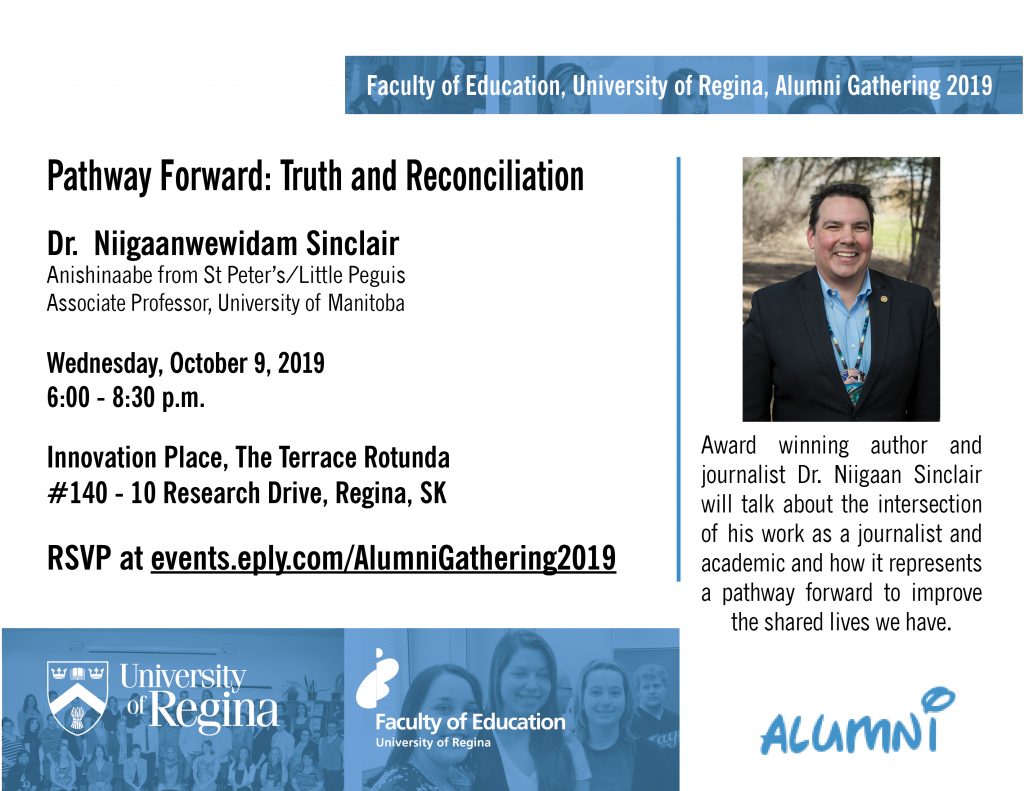

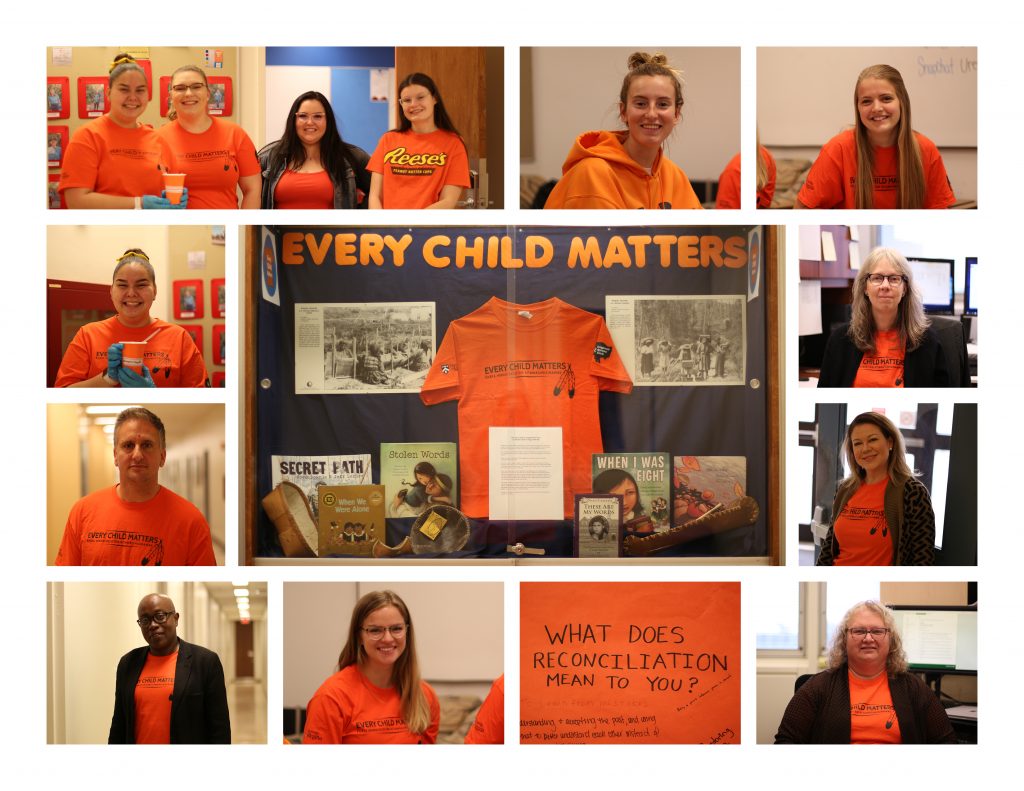
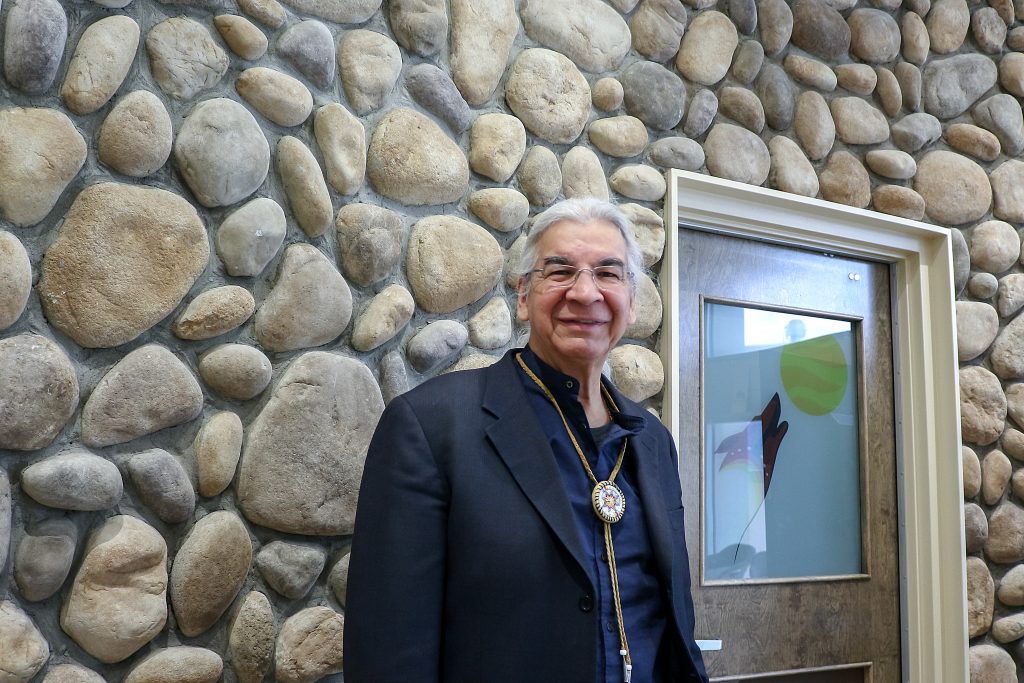
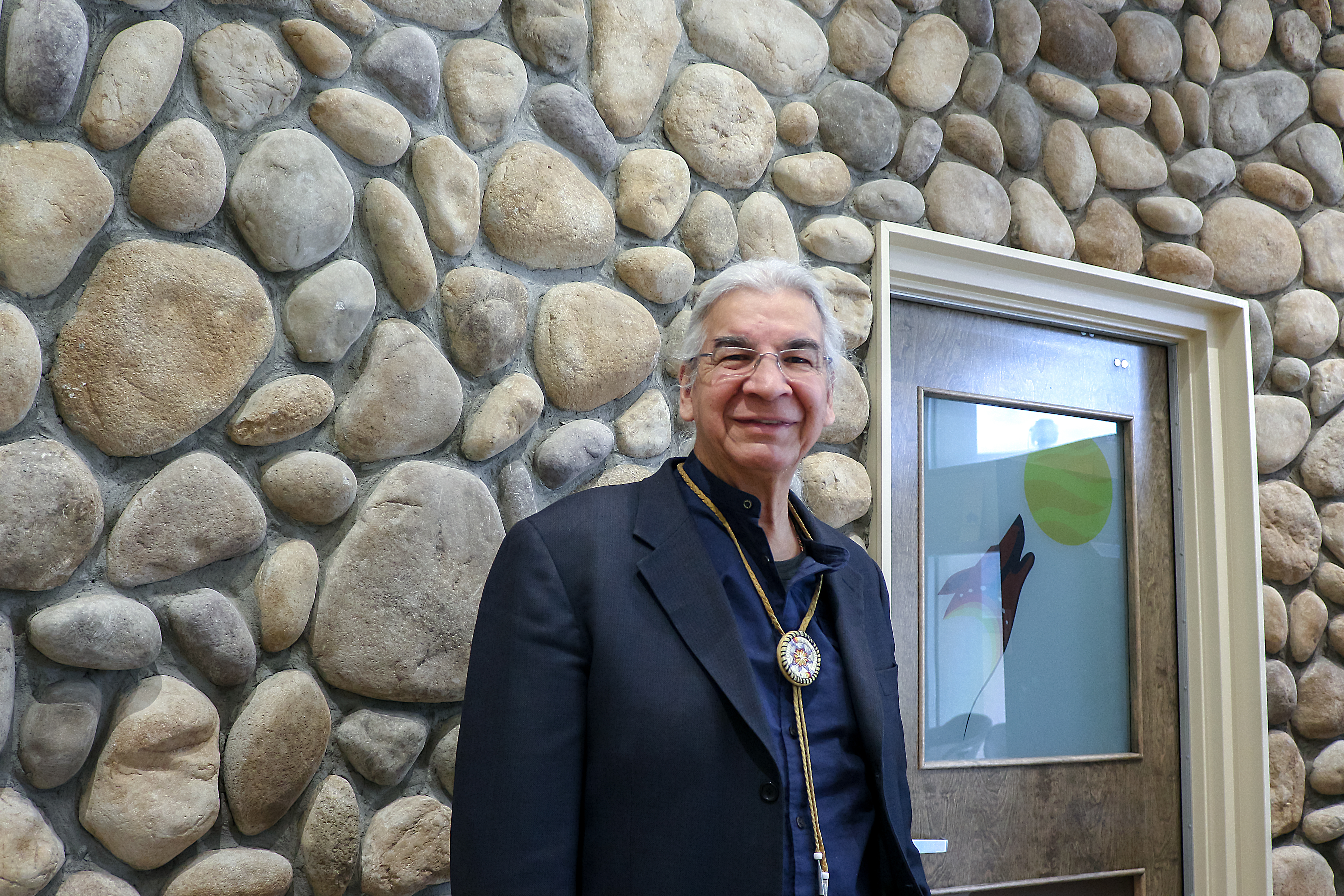 In October 2018, the Faculty of Education’s emerging Elder in Residence, Joseph Naytowhow, a Plains/Woodland Cree (nêhiyaw) singer, songwriter, storyteller, actor, and educator from the Sturgeon Lake First Nation in Saskatchewan, was recognized by the Saskatchewan Arts Board with an award for his contributions to arts and learning. Naytowhow says this award is significant to him, attributing the recognition to “the children and the people I work with, the teachers, and educators, and I share this award with them.”
In October 2018, the Faculty of Education’s emerging Elder in Residence, Joseph Naytowhow, a Plains/Woodland Cree (nêhiyaw) singer, songwriter, storyteller, actor, and educator from the Sturgeon Lake First Nation in Saskatchewan, was recognized by the Saskatchewan Arts Board with an award for his contributions to arts and learning. Naytowhow says this award is significant to him, attributing the recognition to “the children and the people I work with, the teachers, and educators, and I share this award with them.”
This isn’t the first award for Naytowhow, whose work has been recognized by several awards: the 2006 Canadian Aboriginal Music Award’s Keeper of the Tradition Award, a 2005 Commemorative Medal for the Saskatchewan Centennial, the 2009 Gemini Award for Best Individual or Ensemble Performance in an Animated Program or Series for his role in Wapos Bay, the 2009 Best Emerging Male Actor at the Winnipeg Aboriginal Film Festival for his role in Run: Broken Yet Brave and the Best Traditional Male Dancer at the John Arcand Fiddle Fest.
Naytowhow says he appreciates the awards he receives from Saskatchewan, valuing them as “gifts that validate that I have needed both worlds. They’re inseparable.” He considers the awards, as “marking posts in my life that indicated to me that I was someone who had something to share, —I think it validated what I was doing in the spiritual and cultural worlds: nêhiyaw (Cree person) and nêhiyawêwin (speaking Cree), practicing nêhiyaw-isîhcikêwin (Cree culture and ceremony). All I was doing was Indigenous ceremony and culture because that was my life force, my life source.”
At the same time it is difficult to receive the awards because, for Naytowhow, art was never about recognition. He says, “Sometimes you don’t believe it when you’ve been given an award because it’s come from the place that you’ve suffered through and healed through…Everything that I did was about healing. Returning to balance. Everything was about that.”
Naytowhow has invested a lifetime in healing from the trauma of being taken from his family and community at the age of 6, and placed in Indian residential schools for the next 13 years.
“What I went through is one thing, right, 13 years of residential school, is one thing, but you never really understood what you were experiencing academically in education. It didn’t make sense. I didn’t come from that world. I didn’t come from Shakespeare; I didn’t come from math, or from overseas, and yet I was totally immersed in that, and just totally struggled to get through it every step of the way.”
When Naytowhow graduated from highschool, it wasn’t due to academic achievement: “It was like a bull dozer going through a big mud pile, just edging along. I finally got pushed out of that system with a fifty average. I think they just wanted to get me finished. I was really a below average student according to my marks. I was really a very silent learner and you can’t be a silent learner in this system; you have to speak, you have to present, you have to do it their way. And it never really resonated with me,” he says.
After residential school, Naytowhow spent his youth in search of himself. His search for harmony and balance began with attempting to live in the colonial culture. Knowing that education was important to earn a living, Naytowhow, who enjoyed athletics, found a physical education program at a university in Calgary that would accept him with his grades. The program was more about physical performance than academics, and, Naytowhow says, “I did really well; it was all based on skill. I excelled and the first semester my marks were good so I immediately applied to the U of R.” Naytowhow was accepted into the Faculty of Education, but struggled through the next three and a half years before withdrawing from the program. “I was still trying to make sense of this culture that was imposed on me and I sort of got it, but I sort of didn’t. I just barely squeezed by. … I would try to read and I would read for a while and I would fall asleep. I was reading some scientific theory and my mind wanted to write a poem,” he says.
However, after withdrawing from the education program, and while he was working as an Education Liaison for the Friendship Centre, Naytowhow realized that without a degree he wasn’t being taken seriously by the educational administrators, so he decided to finish his Education degree, but this time through ITEP {Indian Teacher Education Program) at the University of Saskatchewan. His practicum took him north to Stanley Mission, to a federally funded school. Naytowhow graduated with a B.Ed., but he didn’t stay in the teaching position he acquired due to a lack of support from the administration.
As Naytowhow continued his search for fulfillment and self, he drifted from job to job, moving from the North to the South, to the further north (NWT) and then back again, trying to fit into the protestant work ethic of 9 to 5 work: “There was something about my experience at residential school that affected my ability to, not so much retain jobs, but stay in a job for any longer than two years. For some reason it was the limit of my mind and body. So I would move; I would want to move: miskâsowin (finding oneself), and opapâpâmacihôs, (moving about in life), that searching for oneself. I wasn’t really fulfilled in the position I was doing. So I would just resign and take off.”
Having children made life a more serious affair and Naytowhow did what he could as a parent to try to maintain stability. He says, “I started being a father and looking after my kids as much as I could within the kind of terrible child rearing that I got through residential school. Some was good, you know; it wasn’t all bad, but it was basically being parented by surrogate parents who didn’t—who couldn’t really take the time to train you to be a young man, a responsible young male, or human being. They just didn’t have time. There was no way they could raise me like a son. So I was trying to raise my own kids from a place of no parenting skills, not learning how to be intimate, not even knowing if I could maintain a job. …. But all along, I really was not feeling fulfilled as a human being, as a male, as a man. I wasn’t being all that society requires for one’s life to be in harmony and in balance, like having the 9 to 5 job, or having a steady income. It happened but it didn’t really make any sense to me.”
What did make sense, what always made sense to Naytowhow, was culture and ceremony: “Singing with the elders or praying with the elders, that was what made sense to me, of anything I was experiencing. The Canadian culture, the protestant work ethic, just didn’t make any sense to me.”
All through his healing journey, Naytowhow was developing an awareness of his Indigenous roots, what he had left behind at the age of 6, the lost memories of loving relationships and experiences with family members and his community. It started first with a realization in his 20s that he was Indigenous (not Canadian as he had been taught), and then the gradual addition of Indigenous culture and ceremony to his life.
While attending the University of Regina, Naytowhow picked up a drum for the first time: “I had a strong urge to go to the drum. I never looked back, ever since I hit that drum.” A visiting visual arts professor from the state of Washington, Leroy of the Yakama tribe, and a colleague, Tim of the Umatilla tribe, introduced him to the drum: “From there,” Naytowhow says, “I went into powwow, into the Sundance, into all the other ceremonies connected through a drum. The drum moved me into the sacred music and songs, and that totally made sense for me to do.”
Naytowhow explains: “My soul was calling out, was being called out, to the elders and ceremonies; that was where I was supposed to be; that was supposed to happen, and I absolutely totally trusted that intuitively.”
“The gifts of music and song and stories that I got from the elders, those were the most critical and most important [awards] that I needed to keep this being alive on this planet. Cause when you’ve gone through residential school, you’ve got extreme trauma that you have to deal with and its always going to be there. Even to this day I still experience pockets of anger and depression and just dark holes that I can’t make sense of, but those stories, or ceremonies, or laughter, anything to do with that, I just had to be there, I had to go there.”
The wisdom of age and experience has given Naytowhow the understanding that “what went wrong, when I went into the colonization culture, was that I tried to be a part of it 100%. I just had to be in and out of it. Had to find short term work and depend on that. That’s probably why I became more a musician and storyteller, became an artist. It was far more flexible and fulfilling as a singer, as someone fascinated by story and fascinated by culture, and I slowly got into acting. For me, I could live there.”
The first time Naytowhow began to consider himself a practicing artist was when he started a residency in Meadow Lake as a storyteller, between 1995 and 2000. He then thought, “Ok, now I can make a living being an artist, being a musician, putting out an album now and then, travelling to storytelling festivals, to music festivals.” His healing journey became the source, he says, “whereby my art practice would flourish and my cultural and spiritual practice. Healing was more a spiritual and cultural journey, more that part, and the art kind of came out of it as a result.”
The Saskatchewan Arts Board Award came with $6000, which is something Naytowhow really appreciates because it allows him to focus on his art: “As an artist, I just need to do the art. But I can’t do it when I’m doing presentations in different areas and being pulled all over. What I need is just some financial support to pay bills and pay my rent. And then I can do songwriting…the things that I do anyway, but I’ve never really been focused as an artist.”
Naytowhow’s healing journey, reconnecting with Indigenous culture and ceremony, and expressed through the arts and education, keeps him connected to both worlds. His presentations begin with Cree concepts, and he relies on the wisdom of the old people to guide him as he educates students. The balance and harmony he has found reflects his Indigenous name, which means “guided by the spirit of the day.”
By Shuana Niessen
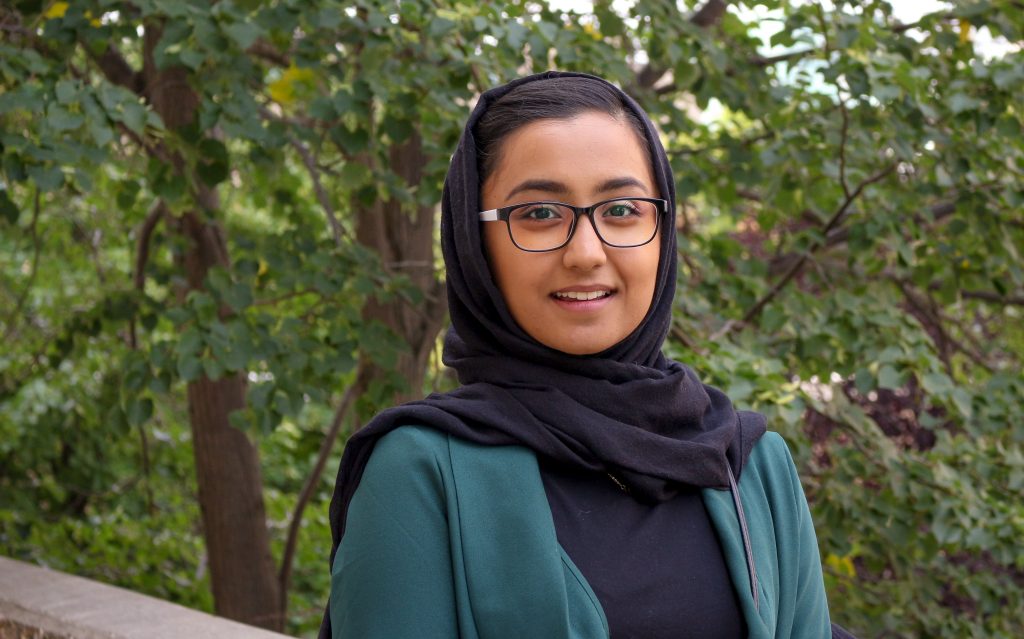
“I know in the long run it isn’t much at all, but in my way, in my journey to reconciliation, I can do this one thing.”
Aysha Yaqoob is no stranger to feelings of discomfort and dislocation. Born in Saudi Arabia and immigrating to Canada at the age of 2 with her parents, who were originally from Pakistan, Yaqoob’s early years were spent moving from place to place in the Greater Toronto Area. Then, in 2008, her family moved to Saskatoon, where Aysha attended school from Grade 7 to 12.
Attending 15 different schools during her K-12 years gave Aysha keen insight into feelings of marginality, which were amplified by being a visibly Muslim student. The lack of representation she saw in professional roles combined with her feelings of marginality sparked a desire in Aysha to work with marginal and at-risk youth, and influenced her decision to become an English teacher.
“In high school I had a great group of English teachers, and they hung out in a nice pack. It was there where I saw how dedicated they were and how fun teaching could be, and I observed their interest in teaching us not only about Shakespeare and poetry, but also about real world problems. However, there were no teachers that looked like me; all the teachers were White, and I wondered, ‘If I feel this, other students must feel this as well.’”
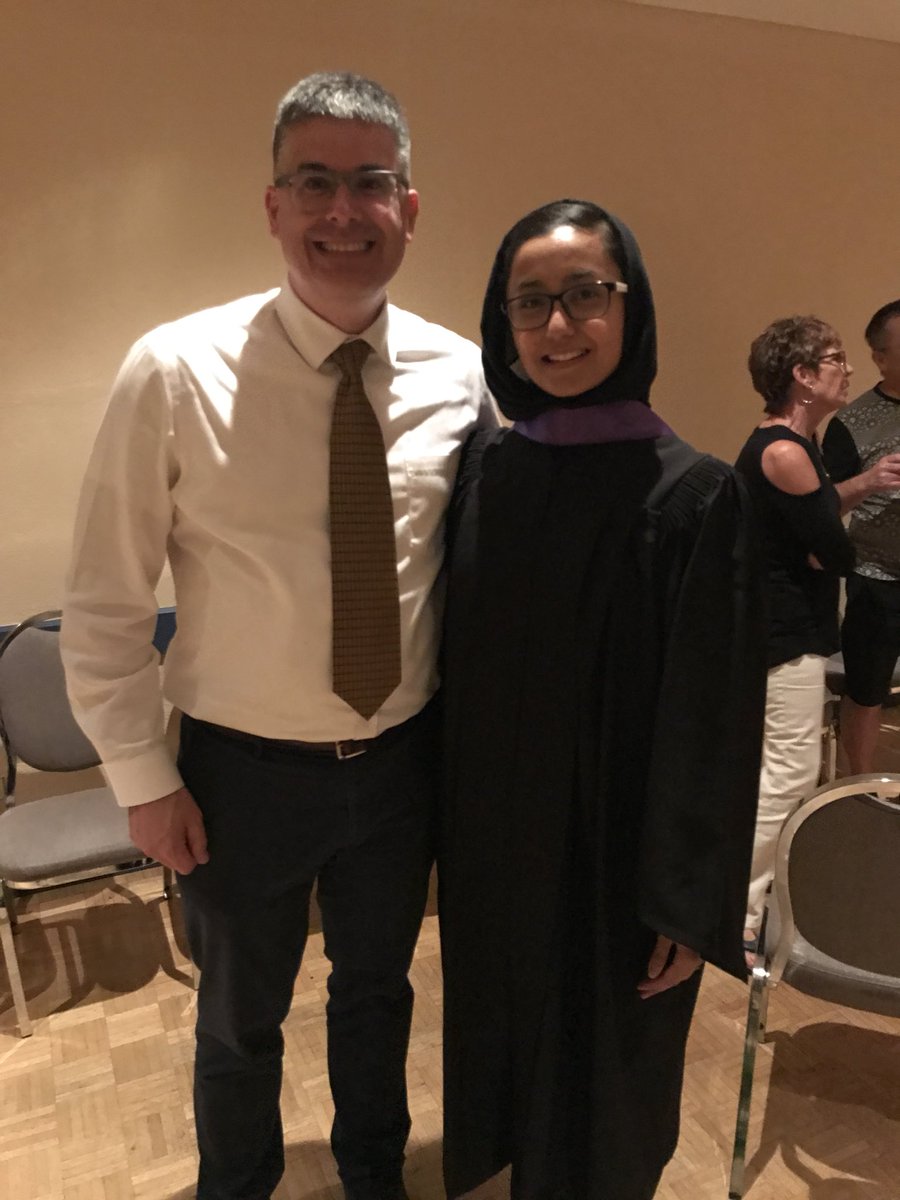
University gave Aysha a sense of control over her learning: “I had full autonomy of where I wanted to push my learning. I remember sitting in Mike Cappello’s ECS class, and seeing a White male talking so strongly about White privilege and what it means to oppress students of colour, and me being one of the very few students in our program who were of colour, and Muslim, visibly Muslim; it felt weird to see someone saying the words I could relate to.” Aysha wanted to learn more about representation: “After that, in every single class I took, I wanted to explore more into representation, and representing marginal and Indigenous students. All my profs were so willing to let me do assignments, I never had a prof who said you have to stick with my assignment. It was so great, I got to push my education and learning in areas that I was interested in. I was really able to shape my journey the way I wanted.”
These experiences changed how Aysha viewed education. She says, “It made me see that there are teachers who are trying to change the system right now, and trying to make students of colour feel represented and welcome. It was so nice.”
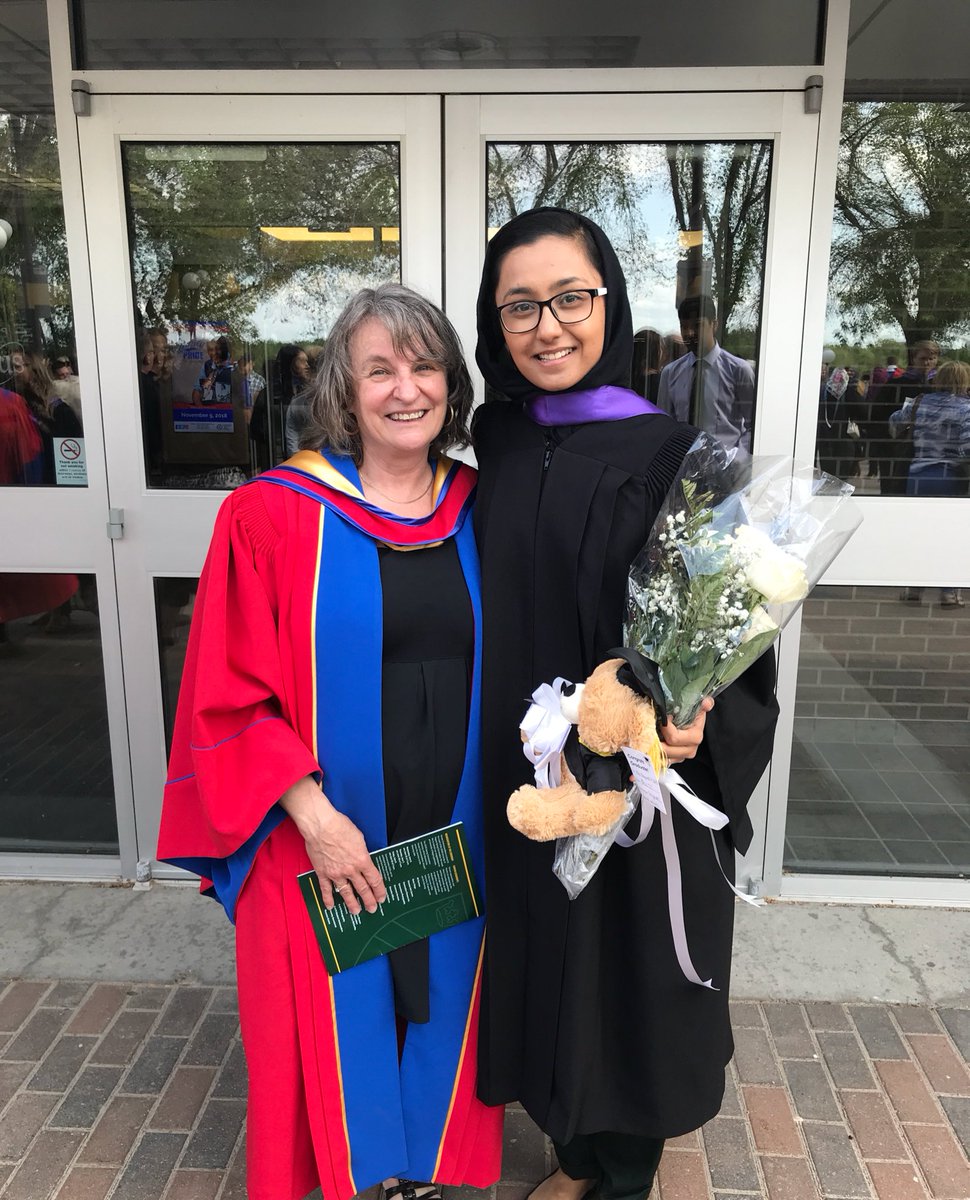
Up to that point, Aysha says she had been quiet and shy, but feeling supported at University helped her find and use her voice. “I remember that during the time when the Muslim ban was going on, I got up in front of my peers and let them know how I felt, how cornered and unsupported I felt. I invited them to a vigil at Victoria Park…Even talking about this gives me goose bumps. Just seeing all of the support I had from my peers and colleagues and professors made me want to speak up about these issues all the more. Since then I’ve been a non-stop machine; I don’t have an off button,” she says.
In 2017, as part of the Education Students’ Society executive, Aysha organized a Professional Development event called Meet-a-Muslim. She says, “I wanted to dispel misinformation about Muslims, so I invited everyone to come out and hear what it was like growing up Muslim, and about how the travel ban was affecting us. I wanted it to be an open safe space to ask questions and dialogue.” For people who are often misportrayed, Aysha explains “My go-to is to just ask questions. I’d rather you ask a billion questions than just assume.” In her quest for how to go about designing the event, Drs. Jennifer Tupper and Mike Cappello advised her to have an open dialogue with a panel. In hindsight, Aysha is glad about the panel format: “It was great that it was that way because a lot of topics came up that I wouldn’t have touched on because for me they were everyday things, even questions about why I wear the hijab and why my sister doesn’t, basic questions about Islam, and my view point on conflicts around the world. I’m not a token representative of all Muslims, so the panel gave a variety of viewpoints,” she says. The event was well-attended, one of the busiest ESS events that year, with 50-60 people attending. CBC covered the event and it was also live-streamed on Facebook.

“My parents look at me now, and they are surprised too, saying ‘You were never like this; you were so quiet and felt uncomfortable with public speaking.’ Now every chance I get, I’m out there.” Aysha credits her transformation as growing out of her experience of feeling supported by her peers and professors: It was “having that moment where I felt enough support to be vulnerable and express how I felt, and sharing that ‘your silence is hurting me,’ and getting their response in return,” she says.
Still quiet in some ways, Aysha likes to achieve extraordinary things while maintaining a low profile. Though she only walked the Faculty of Education’s halls for four years, Aysha managed to earn both a B.Ed. (English Language Arts and Social Studies) and a B. A. in English. Students typically take five years to finish a combined degree program, but Aysha, taking between six and eight classes per term, finished in four years. Aysha laughs, saying, “Nicole Glas, [Student Services Coordinator] asked her ‘Are you sure?’ I said ‘absolutely,’ but I got to the point where I wasn’t sure…I even had a course during internship!”
Pencils of Hope
As if squeezing a 5-year program into four years wasn’t enough, along with serving in the Education Students’ Society for two years (one as VP of Communications), and organizing Meet-a-Muslim night, Aysha maintained her own photography business, and founded a charitable organization called Pencils of Hope.
It was during her second term of University that a plan to support marginalized youth formed in her mind: “The principal from Chief Kahkewistahaw Community School, came in to our class to talk about schooling and education and how it is important for U of R grads to go out on reserves and experience teaching there. I chatted with him later about funding, and learned that federal funding on reserves, and schools on reserves, is significantly less than funding for schools off reserves. I had thought all schools were the same! I remember going home to my parents and talking about it: ‘I want to do something; already there’s such a drastic change between conditions on and off reserves. And all the discrimination that goes on…it doesn’t seem right that in education, especially,—we say Canada has such great education and equal access to education but it doesn’t seem like it.’ So, my parents asked me what I wanted to do. I said ‘I don’t know, but I want to do something.’ Over breakfast, we talked about names, and I thought ‘Pencils of Hope’ was a good name and my dad said, ‘What do you want to do with that?’ I talked to the principal again, and I said, ‘Why don’t I try this? I’m a photographer by hobby. I’ll donate everything I make through photography to this cause. If I can get enough funds, will you accept my gift of supplies to this school?’ I tried it out my first year and it worked out really well.”
Since then the organization has “snowballed,” says Aysha. Sponsors started making small donations. A committee was formed. For the first three years, Pencils of Hope partnered with one school each year. But this year, the committee decided to partner with four schools. “Four schools was a huge difference. We received a grant from Taking it Global, which offered a rising youth grant.”
Donations and, therefore, spending has increased substantially over the four years of existence. The first year the group spent $750 on supplies and this year they spent over $4000, with carry over for next year. Pencils of Hope has made some changes to their vision as well: “This year we’ve changed our vision to match the Calls to Action. So from here on out we made a vow to partner with at least one school on a reserve.” The group is also making supplies available to individual students who may not be in a school that is in partnership with Pencils of Hope.
For Aysha, this work has been part of her journey toward reconciliation. “I know in the long run it isn’t much at all, but in my way, in my journey to reconciliation, I can do this one thing.”
Doing this project in a good way, a humble way, has been one of Aysha’s goals: “When we talk about Pencils of Hope, I don’t like to be called the founder. It is still a journey, still a process; I’m still learning, of course. Meeting with different elders and profs and being able to exchange knowledge, learn indigenous ways of knowing and culture, and how to go about this in a more humble way, it’s been very uncomfortable, but it’s been a great kind of uncomfortable…It’s not learning if it’s not uncomfortable.”
Aysha has learned many things along her journey, but one thing stands out in her mind, “It’s hard doing it alone, not fun to do it alone.” She advises others who would like to do something similar to, “Get many people involved and see what they will do.”
Now a first-year teacher at Balfour Collegiate, Aysha plans to carry on with the work of Pencils of Hope, with the support of her committee, family and community. “I anticipate it is going to be busy, but to me that is a good thing, to me that means more schools and more partnerships, and more relationships—expanding.”
By Shuana Niessen
Reflecting about my time on the land this past week. From learning the #truth about where all the buffalo went, to forming new relationships!! @T4Gathering @URFacofEd pic.twitter.com/ULer4mxXHX
— Ashlee Sandiford (@ashleesandy) September 16, 2018
So thankful to have had this opportunity for experiential learning and reconciliation. We gave thanks to Mother Earth, left with wisdom from the Elders and felt the communal pride exhibited through traditional ceremony and dance. @T4Gathering @UofRegina @URFacofEd pic.twitter.com/C5Gf125VBQ
— rachel.morgan.edprofile (@edprofile) September 15, 2018
#Treaty4 with ECS 311 pic.twitter.com/LOV7DeysX4
— Patrick Scherr (@PatrickRScherr) September 12, 2018
I had an amazing experience today at #Treaty4Gathering. I was able to learn more about the Indigenous culture and being able to connect with the land. pic.twitter.com/a9T1vgBbvD
— Danielle Kelln (@DJKelln) September 12, 2018
I had the privilege of going to the Treaty 4 Gathering with my grade 6’s today! It was so enlightening and I was so happy to run into @jmachnaik in the beading tipi! #Treaty42018 pic.twitter.com/0FXhn1Iq4X
— Keandrah Hanna (@kealshanna) September 12, 2018
Buffalo hide tanning @T4Gathering @URFacofEd preinterns listening, observing, learning the history. #ecs311 pic.twitter.com/VIZ16OLAPo
— Julie Machnaik ᔫᓕ (@jmachnaik) September 14, 2018
With @laurambieber1 and the rest of my #ecs311 class! We had so much fun @T4Gathering yesterday, lots of things to think about today. pic.twitter.com/qbRk7IbkdL
— Maple Jane Baxter (@MsMapleBaxter) September 13, 2018
Had an amazing experience at the Treaty 4 Gathering yesterday! Completing my first blanket exercise was a great step towards reconciliation. @T4Gathering pic.twitter.com/GzKXCcduCB
— Miss. Clark (@MissCla79557883) September 13, 2018
Had an awesome experience at the #Treaty4Gathering today! Participated in the blanket exercise and reconnected with the power of our Mother Earth through the smudging of white sage. pic.twitter.com/6cRqpUR9c7
— Mr. Schutz (@MrSchutz1) September 12, 2018
Bannock on a stick, worth the wait! Thx @URFacofEd profs @PamelaOsmond & Melanie Brice for joining us @T4gathering pic.twitter.com/rsKP70C981
— Julie Machnaik ᔫᓕ (@jmachnaik) September 14, 2018
Had the greatest time at the Treaty 4 Gathering yesterday! pic.twitter.com/4rbPRG4huz
— Harper Morland (@MissHMorland) September 13, 2018
On March 26, Education students from Audrey Aamodt’s Treaties in the Classroom (ECCU 400) section overcame their own discomfort to engage in conversations with peers and profs in the hallways at the University of Regina about the many ways of taking action towards reconciliation. Aamodt says, “Students decided to host these conversations in the halls of the University to remind themselves/us that they not only belong, and have a responsibility, to the more intimate Faculty of Education, but are also part of this larger learning community and beyond.”
Bert Fox High School students and their teacher Sheena Koops, as regular facilitators of the Blanket Exercise, travelled from Fort Qu’Appelle to join the conversations, to raise awareness about the Blanket Exercise, which is an activity in which “participants take on the roles of Indigenous peoples in Canada. Standing on blankets that represent the land, they walk through pre-contact, treaty-making, colonization and resistance ” (Source).
SUNTEP students and their instructors Brenna Pacholko and Russell Fayant visited the stations, and offered, in instructor Aamodt’s words, “critical and courageous conversations with students and myself.” Aamodt adds, “We extend gratitude for their generosity, wisdom, and patience with us.”
Regarding what the students learned, Aamodt says, “I think the most important overall learning that could potentially come out of this experience for us was that listening to and reflecting on critiques takes practice and is necessary. Treaty Education, along with potentially associated reconciliation, decolonization, indigenization, and social justice efforts should always be submitted to critical reflection and none are without tension. So, we ask who benefited from this event and if it was truly ‘action.’ Perhaps it didn’t amount to anything of significance, except to make us feel good. Then, we reminded one another about Pam Palmater’s claim that “if it feels good, it’s not reconciliation.”
As for her own learning, Aamodt adds, ” I have learned how I might better invite students to consider who might be the right people to talk about particular issues, some of the problems with being perceived as positioning ourselves (settler-Canadians) as experts about MMIW, residential school legacies & intergenerational trauma, FNMI identities-histories-cultures-communities, FNMI languages, reconciliation, decolonization, indigenization, and even treaties.”
Below are student comments about what they were doing, and what they thought about its importance.
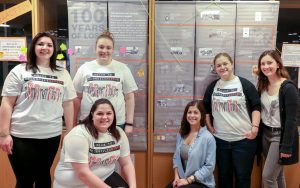
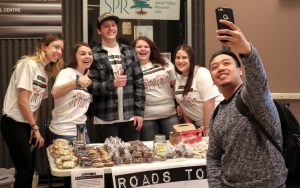
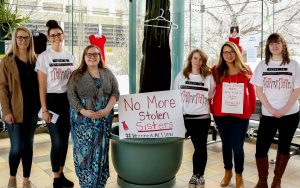
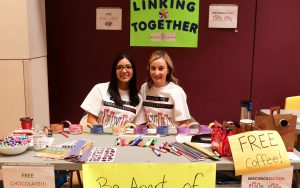
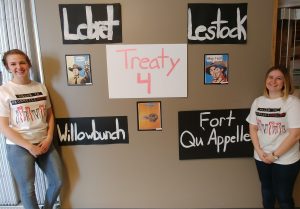
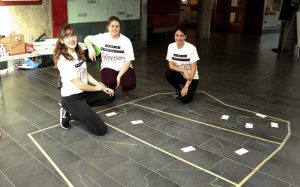
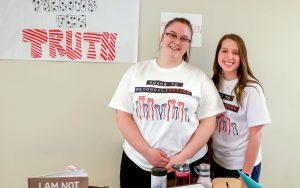
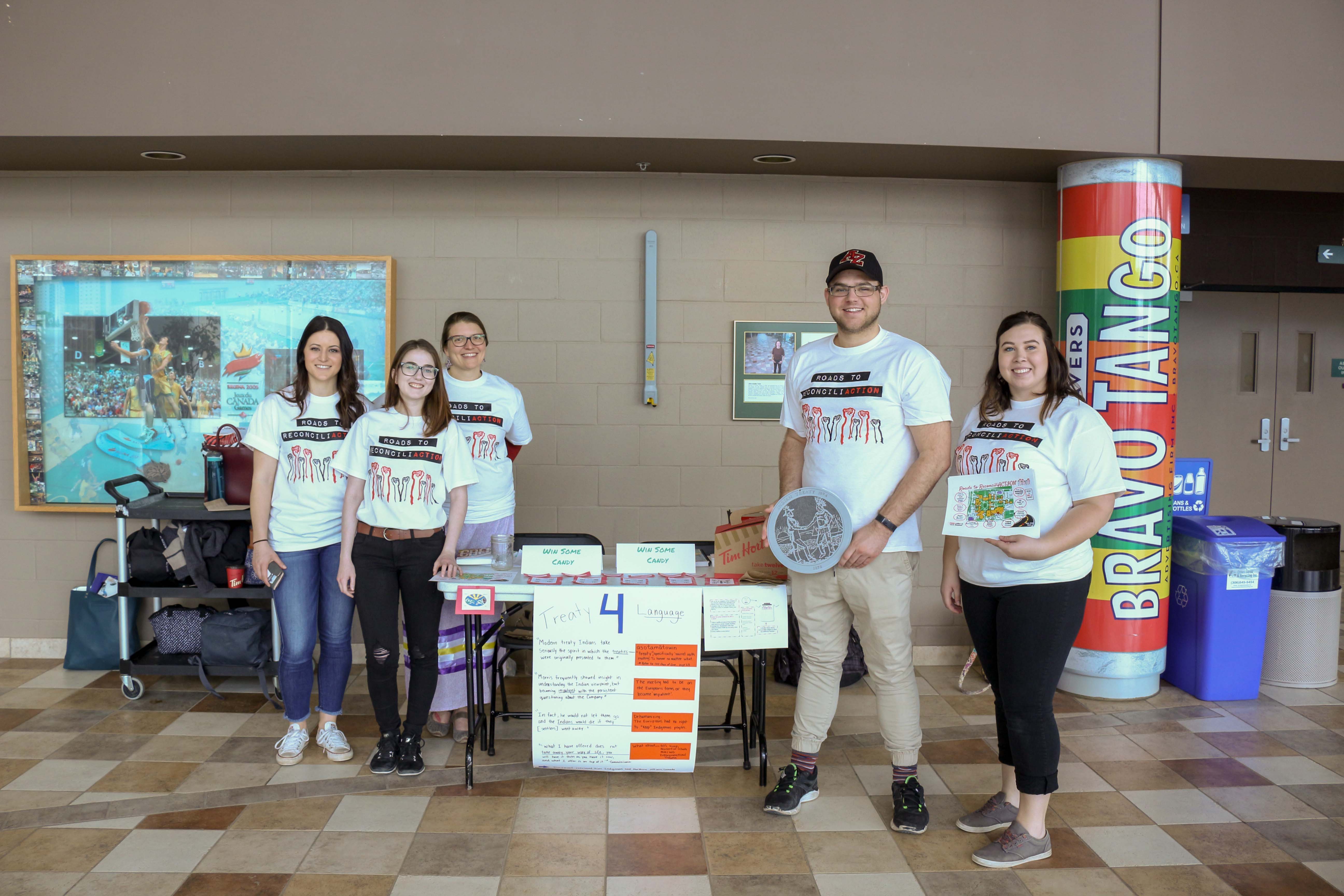
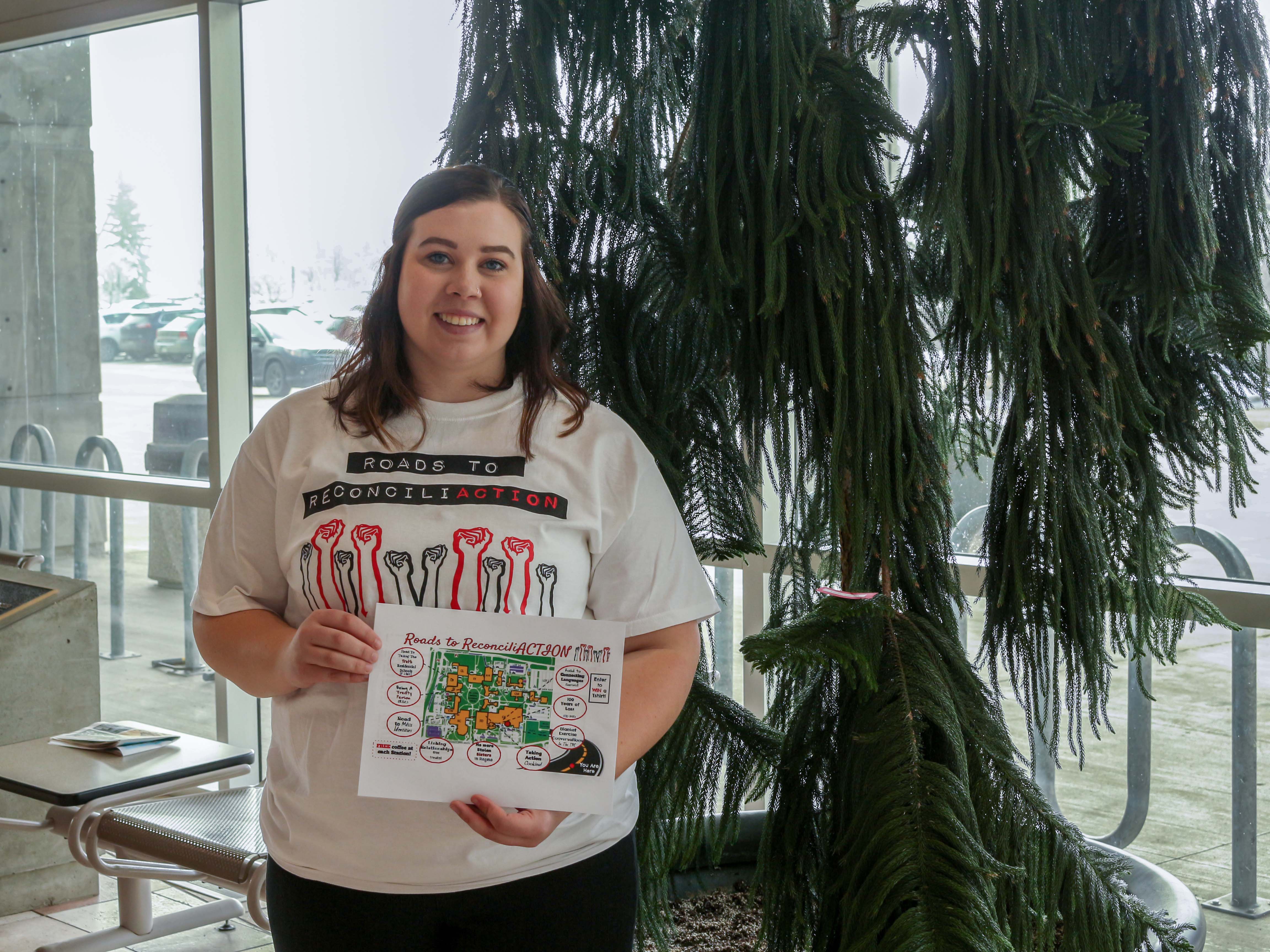

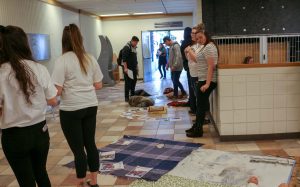
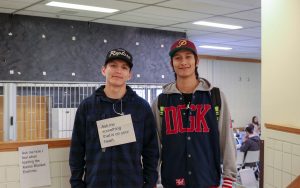
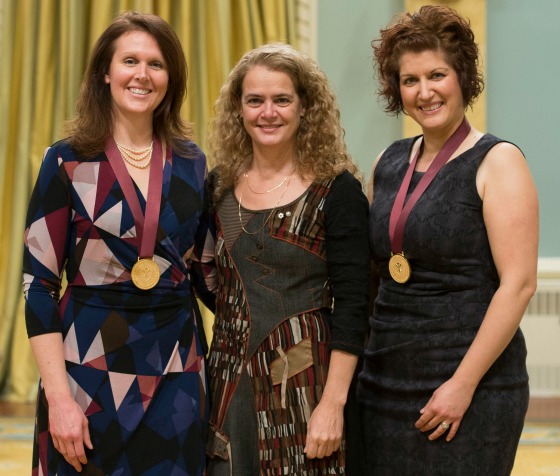
Naomi Fortier-Fréçon and Leia Laing are still relatively early in their teaching careers but they have already left an important legacy.
This past November, Fortier-Fréçon and Laing, both graduates of the U of R, received the Governor General’s History Award for Excellence in Teaching. Governor-General Julie Payette, presented the award at a ceremony at Rideau Hall in Ottawa.
They were recognized for co-founding the Treaty4Project in 2014 while they were teachers at Regina’s Campbell Collegiate High School.
Fortier-Freçon, while still teaching, is a U of R student once again, working on her PhD.
“When we accepted this honour we were very happy to see that our project was recognized at a national level,” says Fortier-Fréçon. “A lot of work and effort was put into this project and it was very exciting to see how this education project has evolved since it began in 2014.”
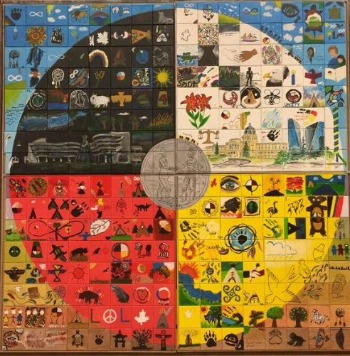
The idea for the project came when Laing and Fortier-Fréçon concluded that students were not receiving the treaty education required.
So they started working on a program.
“First, the inspiration was to find a way to ‘think outside the box’ and find a creative way to teach about treaty education,” says Laing. “We were troubled by the reality that our students seemed to know very little about treaty education and when they knew something we noticed that they weren’t necessarily applying their knowledge in their lives. Therefore, they seemed to know the “right answer” on paper, but unfortunately that reality was not reflected in their actions or relationship with their friends and the community around them.”
The teachers started developing their idea. They searched for input. They approached Calvin Racette who was the Indigenous Education Coordinator with Regina Public Schools.
Racette supported the project from the beginning and suggested the teachers include Noel Starblankett, Knowledge Keeper at the University of Regina and Sandra Bellegarde, Indigenous Education Consultant with Regina Public Schools.
“Noel Starblanket was essential in the creation of this educational project,” says Fortier-Fréçon. “His presence allowed us to learn in a personal way about the importance of treaties. He also guided us regarding the respect of Indigenous protocols and offered support to our students.”
More people came onboard and the project “quickly snowballed into a group of inspired, passionate members who became the founding committee. Together we started to imagine the Treaty4Project,”says Fortier-Fréçon.
The principal aim of the project is for student to understand their generation’s relationship with Treaty 4 in Saskatchewan. The project provides students with an opportunity to engage with community members including elders, Indigenous artists, university professors, activists, and education students.
Laing had the idea to use art to help the students reflect about the meaning of treaties in a creative context. The result was a major mural project with Cri-Métis artist Ray Keighley at Regina’s Scott Collegiate in 2015.
A second mural created in 2017 and created with Cri-Ojibway artist Lloyd Dubois is on display at the library at École Elsie Mironuck Community School in Regina.
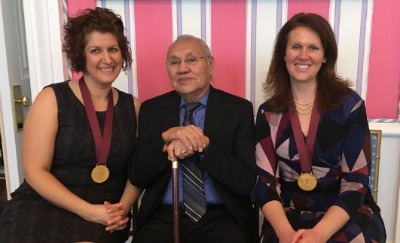
The Treaty4Project founding committee worked on organizing a youth conference to deepen the knowledge previously taught in the classroom and allow members of the community to share their stories with the students. Elders were regularly brought into classes.
More than 200 students from four high schools took part in the first conference in 2015. Two more conferences followed and now a fourth one is scheduled for 2018.
“The Treaty4Project has allowed us to have the opportunity to work in collaboration and build relationships among students, teachers and institutions and this is what we believe to be the true meaning of reconciliation,” says Fortier-Fréçon.
Says Laing: “Using personal stories from guest speakers, our students are invited to unlearn the official narrative and open their heart to other realities that they might not be aware of. Understanding these stories helped our students access a more inclusive history narrative and acknowledge that they have the privilege of living here because in the past a treaty was signed.”
Leia Laing is now teaching Grade 6 at École Monseigneur de Laval. She earned her Bachelor of Education at the U of R in 2008.
Naomi Fortier-Fréçon teaches French Immersion at École Elsie Mironuck Community School in Regina. She earned her Bachelor of Education at the U of R in 2007 and her Master of History at Université de Sherbooke in 2010. She is currently a PhD student in the Faculty of Education working under the supervision of Dr. Fadila Boutouchent.
Laing and Fortier-Fréçon say this project was made possible thanks to the support from:
Saskatchewan Arts Board
First Nations University of Canada
Faculty of Education (U of R)
The McDowell Foundation
Regina public schools
Founding Committee Members:
Noel Starblanket
Calvin Racette
Sandra Bellegarde
Monique Bowes
Hillary Ibbott-Neiszner
Dr. Angelina Weenie
Dr. Kathleen O’Reilly from First Nations University of Canada
Artists Ray Keighley and Lloyd Dubois.
The teaching team since 2015 are all U of R Education alumni:
Heather Findlay – Martin Collegiate
Tamara Ryba – Scott Collegiate
Tana Mitchell – Balfour Collegiate
Tiffany Agopsowicz – Martin Collegiate
Janine Taylor and Jessica Moser – Sheldon Williams
Elizabeth Therrien – Campbell Collegiate
Tracey Ellis – FW Johnson High School.
Other Presenters and Supporters:
Dr. Shauneen Pete (former Indigenous Lead/U of R)
Dr. Anna-Leah King (Faculty of Education)
Dr. Jennifer Tupper (Former Dean of the Faculty of Education)
Dr. James Daschuk, (U of R)
Rap singer Brad Bellegarde (aka InfoRed)
Cadmus Delorme (Chief of the Cowessess First Nation)
Dr. Mike Cappello (Education Faculty) and many more presenters from 2015 to the present day.
University of Regina feature story by Costa Maragos
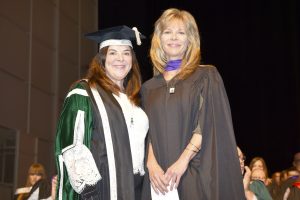
Sylvia Smith, Founder of Project of Heart, received the President’s Distinguished Graduate Student Award at the fall 2017 convocation. This award recognizes outstanding academic performance and is granted to a student whose graduating thesis, exhibition, or performance and the corresponding defense was deemed meritorious by the examining committee.
In an earlier issue of Education News, Sylvia discussed the obstacles she had faced that had delayed the completion of her Master’s degree. She had started her degree in 2011 and was interested in finding out about teachers’ perceptions of Project of Heart, an inquiry-based learning project that examines the history and legacy of Indian residential schools in Canada and commemorates the lives of former students who died while attending Indian residential schools. The project had grown out of students’ demands for more information on this neglected aspect of Canadian history. Sylvia had finished interviewing her participants when, she says, “we had an illness in the family and I became very over-stressed. My work suffered.” Sylvia had to put her thesis work on hold, and by the time she came back to it, Sylvia said, “the landscape had changed so much. When I’d started, materials on Indian residential schools were almost nil…And Project of Heart had grown exponentially!” Her initial vision which was to be a “snapshot in time” had become much more, and she had to face the challenge of figuring out how it would all come together.
Not only did she work through these challenges, Sylvia was the recipient of this prestigious award.
Sylvia says it feels great to be finished. “I can’t believe it’s actually finished. I’ve never really thought of myself as an academic and certainly, with ‘life’ intruding the way it tends to, I never thought I would finish the darned thing. I’m just so lucky to have had a wonderfully supportive spouse and thesis committee (Dr. Carol Schick actually came out of retirement to help out) because they certainly didn’t have to do what they did.”
What excites her about her thesis, Sylvia says, “is that my findings have already been referenced to support work being done around reconciliation and the necessity of teaching *for* justice and more practically, *doing* it.”
Sylvia’s master’s thesis is called: Teachers’ Perceptions of Project of Heart, An Indian Residential School Education Project
Abstract:
The purpose of this study was to gain insight into how settler teachers took up an arts and activist-based Indian Residential School Commemoration Project called Project of Heart. More specifically, it sought to assess whether or not the research participants were led to transformation, demonstrated through disrupting “common sense” (racist) behaviours of teachers and students as well as through their engagement in social justice work that Project of Heart espouses.
Since 2007, Ontario school boards have been required by Ministry policy to teach the “Aboriginal Perspective” in their high school courses, yet at the time of the study (2010), there were still very few resources available for educators to do so. There were even fewer resources available to teach about the Indian Residential School era. Project of Heart was created by an Ontario teacher and her students in 2007 in order to address this egregious situation.
The study was guided by grounded theory methods and the findings suggest that while Project of Heart did not achieve “transformation” in its participants as assessed through teachers’ lack of completion of the social justice requirement, teachers indicated that both students and teachers benefited greatly because of the relevance of the learning.
Defended: April 2017
Thesis Committee
Supervisor: Dr. Marc Spooner
External Examiner:
Dr. Cindy Blackstock, Executive Director of the First Nations Child and Family Caring Society of Canada and professor for the School of Social Work at McGill University
Thesis committee members:
Dr. Ken Montgomery, University of Windsor, Dean, Faculty of Education and Dr. Carol Schick, former Canada Research Chair in Social Justice and Aboriginal Education
Read more about Sylvia and the Project of Heart here: https://www2.uregina.ca/education/news/disrupted-studies-a-teacher-researcher-success-story/